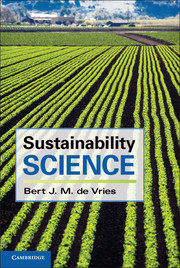Book contents
- Frontmatter
- Contents
- Preface
- 1 Introduction
- 2 The System Dynamics Perspective
- 3 In Search of Sustainability: Past Civilisations
- 4 The World in the Past 300 Years: The Great Acceleration
- 5 Sustainability: Concerns, Definitions, Indicators
- 6 Quality of Life: On Values, Knowledge and Worldviews
- 7 Energy Fundamentals
- 8 On Knowledge and Models
- 9 Land and Nature
- 10 Human Populations and Human Behaviour
- 11 Agro-Food Systems
- 12 Renewable Resources: Water, Fish and Forest
- 13 Non-Renewable Resources: The Industrial Economy
- 14 Towards a Sustainable Economy?
- 15 Outlook on Futures
- Glossary
- References
- Index
- Plate Section
- References
13 - Non-Renewable Resources: The Industrial Economy
Published online by Cambridge University Press: 05 January 2013
- Frontmatter
- Contents
- Preface
- 1 Introduction
- 2 The System Dynamics Perspective
- 3 In Search of Sustainability: Past Civilisations
- 4 The World in the Past 300 Years: The Great Acceleration
- 5 Sustainability: Concerns, Definitions, Indicators
- 6 Quality of Life: On Values, Knowledge and Worldviews
- 7 Energy Fundamentals
- 8 On Knowledge and Models
- 9 Land and Nature
- 10 Human Populations and Human Behaviour
- 11 Agro-Food Systems
- 12 Renewable Resources: Water, Fish and Forest
- 13 Non-Renewable Resources: The Industrial Economy
- 14 Towards a Sustainable Economy?
- 15 Outlook on Futures
- Glossary
- References
- Index
- Plate Section
- References
Summary
Introduction: The Industrial Regime
Until the 18th century agriculture dominated the human economy, with almost everywhere an important role for landed aristocracy, urban military and merchant elites and religious institutions. Around 1750, a new social-ecological regime began: the industrial regime. The beginnings were small, and hardly noticeable to most contemporaries. While human history over the past 10,000 years has been the history of the agrarianisation of the world, the history over the past 250 years has been the history of industrialisation. The metabolic profile of the agrarian socio-ecological regime and the industrial one are quite different (Schandl et al. 2009; §4.3). In the industrial regime, energy and material use per capita is three to five times higher than in agrarian societies. Population densities tend to be three to ten times higher, energy and material use densities even ten to thirty times higher than in agrarian societies. The fraction of biomass in energy supply is a factor three to then lower.
The industrial regime operates on finite stocks that are produced in nature at rates close to zero on a human timescale, hence the name non-renewable resources. They are often referred to as minerals, from the Latin minerale, which means something mined, although later it broadened to ‘substances neither animal nor vegetable’. Most importantly and already known and used in antiquity are sand, salt, glass, limestone and of course metals, and for a few centuries also fossil fuels. Mining and processing minerals to make metal objects has a history of several millennia. Ancient Egypt was renowned for its rich gold, copper, silver and tin mines. There has probably been silver (Ag) mining in Greece since 3500 Before Present (BP): In the 5th century, between ten and thirty thousand miners were at work in the mines of Laureion. A reconstruction of the exploitation history of lead (Pb), from measurements of lead concentrations in Swedish lake sediments, put the first mining back to the period 4000–3500 BP. Concentrations rose towards a peak during the Roman period (2150–1550 BP), declined thereafter and started to rise again with the industrial revolution. It mirrors the European history of lead use of about 300 tons per year (t/yr) in 2700 BP to an estimated 80,000 t/yr around 1950 CE. Mining and processing of minerals for iron (Fe), copper (Cu) and other metals has also increased exponentially.
- Type
- Chapter
- Information
- Sustainability Science , pp. 425 - 471Publisher: Cambridge University PressPrint publication year: 2012



